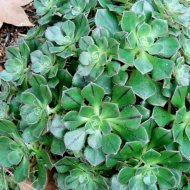Care of the succulent plant Aeonium mascaense or Masca's aeonium |
|
The genus Aeonium, of the Crassulaceae family, comprises 75 species of succulent plants native to the Canary Islands, Madeira, East Africa and Morocco. Some species are: Aeonium mascaense, Aeonium haworthii, Aeonium glutinosum, Aeonium canariense, Aeonium arboreum, Aeonium percarneum, Aeonium undulatum, Aeonium spathulatum, Aeonium sedifolium, Aeonium virgineum, Aeonium hierrense. Common name: Masca's aeonium. This species is native to Barranco de Masca, Tenerife (Canary Islands). They are succulent plants of almost creeping size that reach 30 cm (1 feet) height. The leaves are fleshy and hairy, appear in rosettes, are bluish-green in color and have a spatulate-claviform shape. The flowers are small, white or pink, and appear in groups above the leaves. They bloom during the first half of spring. Aeonium mascaense is used in pots, in rockeries, on dry slopes as coverings and in cactus and succulent plant gardens. Masca's aeonium is an easy to grow plant that can be grown in direct or semi-shade exposure. The winter temperature must not be less than 8 ºC (46.4 ºF). Good soil drainage is very important; They can grow in poor, sandy soils but appreciate that it contains some organic matter. They are very resistant to drought plants, so watering every 15-20 days in spring and summer, once a month in autumn and every 2 months in winter will be sufficient. Aeonium mascaense appreciates a light fertilization with compost in late winter. They do not require pruning but it is advisable to eliminate the withered flowers after flowering. Its worst enemy is excess moisture; If the heat is very intense they can be attacked by mealybugs. Aeonium mascaense can be easily propagated by means of leaf cuttings rooted in a sandy substrate in spring or summer; It can also be made from seeds sown in spring. |
Images of the succulent plant Aeonium mascaense or Masca's aeonium |
Find plants
Aeonium mascaense or Masca's aeonium | Care and Growing
© 2025 FavThemes









